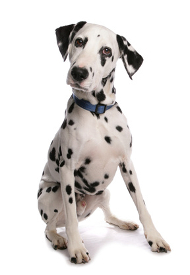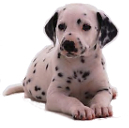
Pros and cons Dalmatian
Potential Dalmatian dog owners need to be aware of some pros and cons associated with owning this large dog breed. This breed is suitable for active families, as Dalmatians have a lot of energy to spend. Dalmatian dogs are ideal for people who like to jog with a dog or even go for a bike ride with a pet. Dalmatians have lots of endurance and energy to spend during the day, making this breed a good playmate for active kids. Other pros of owning a Dalmatian include the breed's innate affinity with horses. Dalmatians are also good with other dogs and pets.
Cons of owning a Dalmatian include the dog's endless energy. Only people who can provide a Dalmatian with long daily walks and plenty of running space should consider this breed. Dalmatians need an access to exercise areas so that the dog can release some energy during the day, otherwise behavior issues tend to develop if the dog doesn't get the needed amount of exercise. Other disadvantages to owning a Dalmatian include the fact that this breed is difficult to train. The independent temperament of a Dalmatian dog makes training this breed a challenge, especially for novice dog owners. Other cons include Dalmatian's stubborn temperament and this breed can be a lot of work during the first year or two, while the dog is learning basics of good behavior. A high percentage of Dalmatians are born deaf in comparison to many other dog breeds, which is another disadvantage.
Dalmatian shedding
Do Dalmatians shed? Yes, Dalmatian dogs do shed and require daily brushing to minimize the amount of loose dog hair around your home. You may want to brush your Dalmatian outside to make the clean up easier as there will be a considerable amount of dog hair flying around. Heavy shedding occurs twice a year, typically in the fall and in the spring. Having the right tools to manage Dalmatian shedding can make a big difference. Furminator deshedding tool can be used to keep Dalmatian shedding to a minimum. See video below where a Dalmatian owner is testing a Furminator brush.
Furminator deshedding tool
If you noticed an increased amount in Dalmatian shedding accompanied by other symptoms such as inflamed or itching skin areas, be sure to check with the vet to rule out any health conditions that may contribute to an increase in the dog's shedding.
Feeding the Dalmatian with a breed specific dog food helps to meet the dietary needs of the Dalmatian dog breed. Dalmatian's overall appearance and the condition of the dog's coat improves with the right diet.
Dalmatian size
How much do Dalmatians weigh?
Dalmatian male weight: 33 to 70 lb (15 to 32 kg)
Dalmatian female weight: 35 to 52 lb (16 to 24 kg)
Dalmatian size:
Dalmatian male height: 20.87 to 25.98 in (53 to 66 cm)
Dalmatian female height: 18.11 to 25.20 in (46 to 64 cm)
Dalmatian coat: short, find and dense
Dalmatian colors: black or brown spots on a white background
How many puppies can a Dalmatian have?
Dalmatian litter size: 6 to 9 puppies
Dalmatian lifespan:
Dalmatian life expectancy: 11 to 13 years
How much does a Dalmatian cost?
Dalmatian prices start at $1,000 and up depending on many factors
 Dalmatian temperament
Dalmatians are intelligent dogs with an independent temperament. Without the proper training, they can be willful and stubborn. Dalmatians make good watchdogs thanks to their strong guarding instinct. This breed can be aggressive toward strangers. Dalmatians need a lot of attention and running space as they are considered to be a high energy breed. Dalmatian has strong legs and muscular body that enables the dog to be a great jogging companion. Don't get a Dalmatian unless you're ready to wake up early and go for long walks. Energetic dogs such as the Dalmatians do best with an active owner who enjoys spending lots of time with the dog. The breed is very versatile and has been used as sporting dogs, birding dogs, trail hounds, boar hunters and even retrievers. One of the most prominent roles for Dalmatians is one of coaching dogs. The dogs get along splendidly with horses, making this breed ideal to run alongside carriages and ward off stray dogs as well as keep the horses calm. This job eventually translated to the firehouse where Dalmatians would run behind fire trucks. Horses were skittish around fire, but the Dalmatians kept them composed. Dalmatians also protected the strong horses used by the fire engines from theft and served as guard dogs.
Another important role for Dalmatians is to keep firehouses free of rats and mice. Start socializing your Dalmatian at a young age with children as well as with other dogs and pets. The more active the family is - the more active the dog will be. Are Dalmatians good with kids? Dalmatians make wonderful companions for older kids. Not recommended for families with toddlers or kids under the age of 10 years old. Adolescent Dalmatians may be too boisterous for a household with young kids. Dalmatians are people oriented and are happiest around their family. When happy, these lively dogs can curl their lips into a smile, which can be mistaken for an aggressive gesture by someone who is not familiar with the breed. Dalmatian's active temperament is not for sedentary people as the dog needs plenty of exercise every day to release all the energy and Dalmatians are known to be a high energy breed. Dalmatians make great jogging partners for people that like to jog.
Housebreaking a Dalmatian may take some time. With patience and consistency it is possible to have the dog fully housetrained. Watch for the signs of readiness to use the toilet and as soon as you notice that your dog is sniffing the floor or walking around in circles, take him outside to the designated dog toilet area. As soon as the dog completed his business, reward him with a small treat and a praise. In case of an accident do not punish the dog. Casually clean up the mess and be on the lookout for the dog's readiness to use the toilet next time. Rewarding good behavior and ignoring accidents is the strategy that works during Dalmatian potty training.
Does a Dalmatian need a crate? Any dog can benefit from having a crate that is used correctly by the dog's owner. A dog crate provides the dog with a safe area where the dog can relax and enjoy peaceful time. Crate is a safe way to transport a dog and when the dog is crate trained before the trip, he will feel less stressed and more secure during the trip because he is spending hime in a familiar environment. Crates should never be used as a way to punish the dog. A crate is a tool that should be used with caution - do not let your dog spend hours on end in a locked crate. A crate can be used to keep the busy Dalmatian puppy out of trouble if you are not around for an hour or two. A crate can be used as the dog's sleeping area. For younger puppies that aren't fully housetrained, use newspaper on the crate's floor for easier clean up in case of an accident. Potty trained Dalmatians are comfortable with a crate bed or a soft towel on the bottom of the crate.
When you are getting a new crate for a Dalmatian puppy, get one that can accommodate a full grown Dalmatian dog and use a crate separator that many crates come with to allocate enough space for the puppy. Too much space in a crate will inspire your dog to use the extra space as his toilet and will make potty training more difficult. A properly sized crate should have enough space for the dog to stand freely full height, to turn around easily and to stretch out when the dog is laying down.
How to care for Dalmatian dog
Dalmatians do not have the distinct dog odor that most other breeds have because their coat produces minimal amount of oil. When they are born, Dalmatians are all white and they start to develop their famous spots at around 4 weeks old. Dalmatians even have spots on the inside of their mouths.
Dalmatian is a short-haired breed. The short coat may not be enough to protect the dog from cold. The dog needs a winter coat or a sweater when going outside during the cold days.
Brushing your dog's teeth every day will help to remove plaque. If the Dalmatian's teeth aren't regularly cleaned, plaque can turn into yellow tartar on the dog's teeth that harbors bacteria and can cause dental issues, bad breath and other medical issues with your pet. Brush Dalmatian's teeth regularly to help keep your pet healthy.
Keep your Dalmatian's ears clean and remember to use a soft, dry towel to wipe his ears after bath or after swimming. Dog ear wipes are convenient and make it easy to keep Dalmatian's ears clean.
Dalmatian grooming involves trimming the dog's nails about once every six weeks or as soon as you can hear the dog's nails making a clicking sound whenever he's walking on a hardwood floor. If you accidenally cut your dog's nail too much and the dog nail is bleeding, styptic powder can quickly help stop bleeding.
Dalmatians health issues
One of the cons to owning a Dalmatian is that this breed is genetically predisposed to deafness. Only about seventy percent of Dalmatians have normal hearing. One interesting fact is that Dalmatians with large amount of patches present at birth may have a lower rate of deafness. Selecting for this trait may reduce the frequency of deafness in the breed. However, patches are a disqualifying factor in Dalmatian breed standards in an effort to preserve the spotted coat (the continual breeding of patched dogs would result in heavily patched Dalmatians with few spots). Dalmatians are prone to kidney and bladder stones as their liver has trouble breaking down uric acid. As a result, Dalmatian males over 10 years of age are prone to kidney and bladder stones and should have their calcium intake reduced or be given preventive medication.
Dalmatian origin
Many historians agree that the ancestors of the Dalmatian may have been pointers and the spotted Great Dane. And while the breed did not originate in Dalmatia, located in the southern region in Croatia, the breed did derive its name from the region. In Victorian England, the Dalmatian served as a coach dog, fulfilling both aesthetic and practical roles - keeping the horses safe from marauding dogs while looking handsome. The dogs trotted in front, alongside, or below the axle of the coach.
There is now evidence that the coaching role may have been a hereditary factor that was bred into the Dalmatian. George Washington was one of the first breeders of Dalmatians in the United States. Today the breed is a popular mascot of many fire departments. The first Dalmatian was registered with the American Kennel Club in 1888 and the breed's U.S. Club, the Dalmatian Club of America, was founded in 1905.
Medium sized dog breeds pros and cons
American Cocker Spaniel shedding
American Pit Bull Terrier pros and cons
Australian Shepherd pros and cons
Basenji pros and cons
Beagle shedding
Border Collie shedding
Boxer pros and cons
Bulldog pros and cons
Poodle pros and cons
Husky dog pros and cons
Medium sized dog breeds compared
|